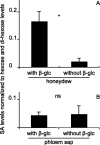Whiteflies glycosylate salicylic acid and secrete the conjugate via their honeydew
- PMID: 25563984
- PMCID: PMC4303718
- DOI: 10.1007/s10886-014-0543-9
Whiteflies glycosylate salicylic acid and secrete the conjugate via their honeydew
Abstract
During insect feeding, a complex interaction takes place at the feeding site, with plants deciphering molecular information associated with the feeding herbivore, resulting in the upregulation of the appropriate defenses, and the herbivore avoiding or preventing these defenses from taking effect. Whiteflies can feed on plants without causing significant damage to mesophyll cells, making their detection extra challenging for the plant. However, whiteflies secrete honeydew that ends up on the plant surface at the feeding site and on distal plant parts below the feeding site. We reasoned that this honeydew, since it is largely of plant origin, may contain molecular information that alerts the plant, and we focused on the defense hormone salicylic acid (SA). First, we analyzed phloem sap from tomato plants, on which the whiteflies are feeding, and found that it contained salicylic acid (SA). Subsequently, we determined that in honeydew more than 80% of SA was converted to its glycoside (SAG). When whiteflies were allowed to feed from an artificial diet spiked with labeled SA, labeled SAG also was produced. However, manually depositing honeydew on undamaged plants resulted still in a significant increase in endogenous free SA. Accordingly, transcript levels of PR1a, an SA marker gene, increased whereas those of PI-II, a jasmonate marker gene, decreased. Our results indicate that whiteflies manipulate the SA levels within their secretions, thus influencing the defense responses in those plant parts that come into contact with honeydew.
Figures





Similar articles
-
Airborne host-plant manipulation by whiteflies via an inducible blend of plant volatiles.Proc Natl Acad Sci U S A. 2019 Apr 9;116(15):7387-7396. doi: 10.1073/pnas.1818599116. Epub 2019 Mar 25. Proc Natl Acad Sci U S A. 2019. PMID: 30910967 Free PMC article.
-
A salivary effector enables whitefly to feed on host plants by eliciting salicylic acid-signaling pathway.Proc Natl Acad Sci U S A. 2019 Jan 8;116(2):490-495. doi: 10.1073/pnas.1714990116. Epub 2018 Dec 24. Proc Natl Acad Sci U S A. 2019. PMID: 30584091 Free PMC article.
-
Reduction in the fitness of Bemisia tabaci fed on three previously infested tomato genotypes differing in the jasmonic acid pathway.Environ Entomol. 2012 Dec;41(6):1443-53. doi: 10.1603/EN11264. Environ Entomol. 2012. PMID: 23321091
-
Whitefly interactions with plants.Curr Opin Insect Sci. 2017 Feb;19:70-75. doi: 10.1016/j.cois.2017.02.001. Epub 2017 Feb 13. Curr Opin Insect Sci. 2017. PMID: 28521945 Review.
-
Phloem-sap feeding by animals: problems and solutions.J Exp Bot. 2006;57(4):747-54. doi: 10.1093/jxb/erj067. Epub 2006 Jan 31. J Exp Bot. 2006. PMID: 16449374 Review.
Cited by
-
The Salicylic Acid-Mediated Release of Plant Volatiles Affects the Host Choice of Bemisia tabaci.Int J Mol Sci. 2016 Jun 30;17(7):1048. doi: 10.3390/ijms17071048. Int J Mol Sci. 2016. PMID: 27376280 Free PMC article.
-
Maize Plants Recognize Herbivore-Associated Cues from Caterpillar Frass.J Chem Ecol. 2015 Sep;41(9):781-92. doi: 10.1007/s10886-015-0619-1. Epub 2015 Aug 26. J Chem Ecol. 2015. PMID: 26306592
-
Comparative analysis of salicylic acid levels and gene expression in resistant, tolerant, and susceptible cassava varieties following whitefly-mediated SLCMV infection.Sci Rep. 2023 Aug 21;13(1):13610. doi: 10.1038/s41598-023-40874-3. Sci Rep. 2023. PMID: 37604906 Free PMC article.
-
Herbivory and relative growth rates of Pieris rapae are correlated with host constitutive salicylic acid and flowering time.J Chem Ecol. 2015 Apr;41(4):350-9. doi: 10.1007/s10886-015-0572-z. Epub 2015 Apr 17. J Chem Ecol. 2015. PMID: 25893789 Free PMC article.
-
New insights into azelaic acid-induced resistance against Alternaria Solani in tomato plants.BMC Plant Biol. 2024 Jul 19;24(1):687. doi: 10.1186/s12870-024-05397-7. BMC Plant Biol. 2024. PMID: 39026164 Free PMC article.
References
-
- Agtuca B, Rieger E, Hilger K, Song L, Robert CAM, Erb M, Karve A, Ferrieri RA. Carbon-11 reveals opposing roles of auxin and salicylic acid in regulating leaf physiology, Leaf metabolism, and resource allocation patterns that impact root growth in Zea mays. J Plant Growth Regul. 2013;33:328–339. doi: 10.1007/s00344-013-9379-8. - DOI
-
- Alba JM, Glas JJ, Schimmel BC, Kant MR. Avoidance and suppression of plant defenses by herbivores and pathogens. J Plant Interact. 2011;6:221–227. doi: 10.1080/17429145.2010.551670. - DOI
-
- Alborn H, Turlings T, Jones T, Stenhagen G, Loughrin J, Tumlinson J. An elicitor of plant volatiles from beet armyworm oral secretion. Science. 1997;276:945–949. doi: 10.1126/science.276.5314.945. - DOI
Publication types
MeSH terms
Substances
LinkOut - more resources
Full Text Sources
Other Literature Sources
Research Materials
Miscellaneous

